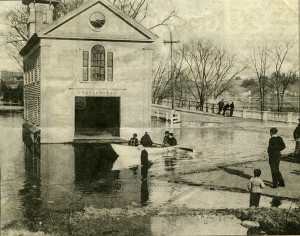
The Rocks Village Hand Tub House is described in the 1985 Massachusetts Historical Commission (MHC) Reconnaissance Survey Town Report as “a combination tub house / meeting hall” from the early industrial period (1830-1870). It resides in the Rocks Village Local Historic District which was listed in the National Register in 1976.
Called a hand tub house because it housed manually operated fire-fighting pump. The building was constructed primarily using Federal stylistic elements, however the window above the fire door on the façade of the building gives the building a slight classical air. This type of tri-part window is known as a Palladian window is most common in classical revival styles. The remaining windows are 9 over 9.
The fire department of East Haverhill is worthy of mention.
Over one hundred years ago this little village had a fire engine, then
quite a novelty, the water had to be pumped into the tub, and then
poured onto the fire; later they had another fire tub as they were
called, and in 1851 they sold the tub, and it went to Hammondsville,
Ill., and the fire engine named “The Tiger” was sent down from the
town center, and is at present the protection against fire for the
village; it is named “Protector No. 3.” This Rocks Village fire
company was made up of the solid men of the town, and they responded
to calls in their own town, and before West Newbury had an engine, if
a fire broke out in that town, a quick run over the bridge, brought
them over as helpers. The company did much of this missionary work
among their neighbors on all sides. (smith)
In 2011 the City of Haverhill received funding from the state historical commission to repair and restore the brick piers and also the buildings masonry. Owned by the City of Haverhill and under stewardship of the Rocks Village Memorial Association, the building does not currently have any permanent function but is occasionally used by the memorial association as a function space and a meeting hall; however the association plans to turn it into a museum and education center.
1827: Town raises money to build engine houses. Rocks Village was built in 1829.
1829, Rocks Village organizes a self governed, self supported call fire company. Haverhill Engine Company #5 (From Haverhill Firefighters Museum)
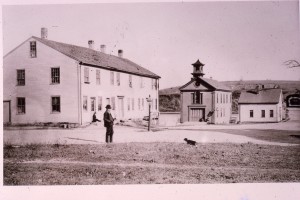
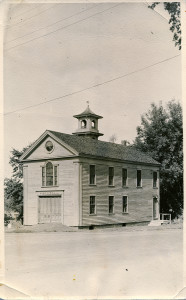
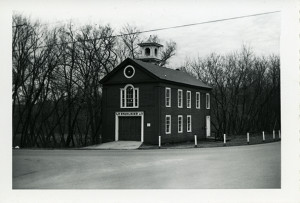
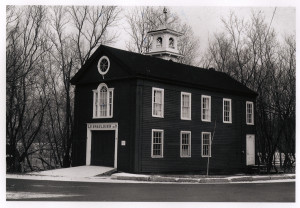
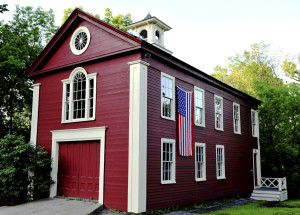
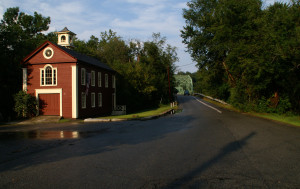
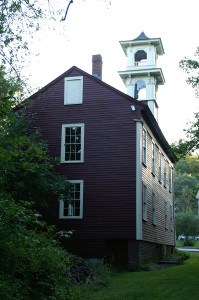
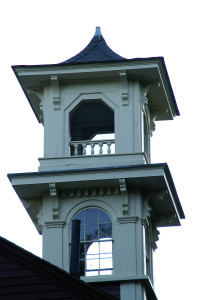
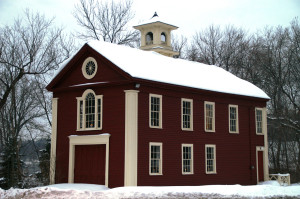
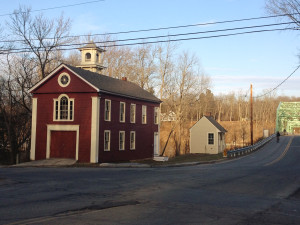
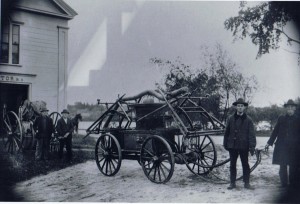
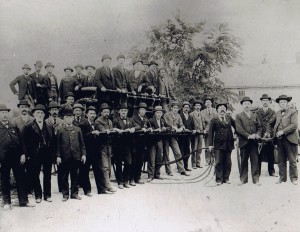
1851: Protector #3 was under the command of Captain Stephen Noyes, was in full operation in the second half of the 19th century.
1859: There were six independent fire companies in Haverhill. Protector #3 was in Rocks Village.
In the March 25, 1865 Tri-Weekly Publisher, James Davis sends a card “This subscriber hereby tenders his sincere thanks to the Protector Engine Company for their valuable service in extinguishing the fire which destroyed [his] property on the 20th instant.”
According the Protector #3 account book from 1864-18XX the following are listed
Charles Carr
Joseph Carr
William Cooper
Augustus S. Chase
Many Colbys
George Elliott
John R. Estabrook (1866-1867)
Joseph Esterbrook
William Elliott
John L. Estabrook
William Evan
Jordan G Getchell
D. L. Getchell
Charles Hoyt
Albert Hoyt
Moses Jaques
John Jaques (might have been treasurer or secretary)
Charles C. Ramsey
William H Ramsey (look like might have been treasurer)
Amos Morse
John B. Nichols Jr.
Ruman Maynard
John Kimball
Frederik Kimball
Albert E. Kenison
Martin Orne
John Osgood
John L. Orne
Hazon E. Ordway (son of Theodore and Mary Carr Elliott)
Charles E. Ordway (son of Theodore and Mary Car Elliott)
Thomas G. Orne
James M. Pecker
William Sawyer
George S. Stickney
Augustus H. Taylor
Richard Welch
William Hull
W.P.Goodwin
In 1872, most were paid 11.00. There was a 1.00 yearly fee. If you left the meeting or skipped a meeting you were fined .25 and .5 respectively.
W. P. Goodwin was paid 25.50 in 1872.
1875 City Expenditures for Haverhill. (pg 57) Included $2000.00 for Protector House and land (pg 91) Protector Engine was sold for $150.00. Protector land and house $1500 page 146. Protector #3 (Rocks Village) page 53. D. D. Chase and Sons for lumber $1.75. page 96. Salaries for Rocks Village page 67. William Jones was paid 21.50 to paint the engine house.
1875: Hand engines were replaced with chemical engines at both Ayers Village and Rocks Village.
1875: improvements were made to the upper hall for $1,000 and included “carpet of rich texture and tasty design, black walnut settees upholstered in haircloth, and several fine pictures.”
Page 39
James W. Colby — Cleaning: 12.00
shoveling snow and making fires: 10.00
Hazen Kimball — storing Engine: 16.00
drawing engine to and from fires: 2.00
Charles Smiley — Coal: 18.00
Pay of Men: 572.58

1900 census lists William Goodwin as head of household (wharf lane??) being 64 having been born Apr 1836. Listed as Shoemaker
Maybe: Frederic W. P. GOODWIN (xxx- xxx) married Salome COLBY (1818 – xxx) 29 OCT 1836 in Amesbury, Essex County, Massachusetts.
Frederic W. P., and Betsy [W. int] Hoyt of Newton, NH, Dec 30, 1840 [Dec 1, 1841 int]*
Some other charges
E. H. Jaques was paid for music at the muster.
Mrs H. Ramsey is paid for uniform by the Protector #3 fire station.
Sept 1864 paid F. F. Maynard for Car(d)
Paid Sawyer and member for Fare at Muster
Paid W. F. Bailey for drawing engine to muster and feeding horses.
Paid Allen Short for drumming
Paid William Sawyer for Fare to muster and drawing engine
1872, July 29: 55.00 was paid for the flag staff
1902 Haverhill and Groveland Directory: PROTECTOR NO. 3., Rocks Village, East Haverhill., S. E. Colby, Capt.; W. M. Ramsey, Clerk; Samuel Chapman.
1955: Rocks Village had a motorized engine. It was put into the Hand Tub House and it fell through the floor. In 1955, the present Rocks Village Station was built.
2011: Foundation repair
2013: Roof Repair
2016: Electrical Upgrade
2018: Back restoration and full building painting
2019: Settee project completed
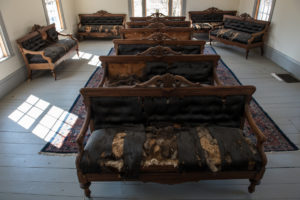
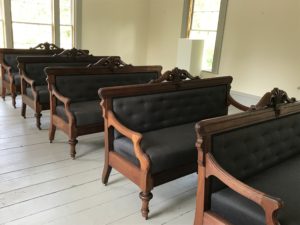
Deeds
1732: John Swett to Green Whittier Inn Holder (63/184), Dwelling House, Barn and the little Hog or hayxxxxxxxxxxx. 1/4 acres. Starting at the north corner of John Swett land and running westerly 10 to 12 R to a stake and stone on the south side of the brook then running southwesterly to a fence joining the highway, running easterly toward river taking 1R in breadth south of house on land running 1R east of the dwelling house and then running northerly on a straight line to the stake first mentioned with all the buildings.
1736: Green Whicher (Whittier) to Benjamin Swett (78/43) Dwelling House, Barn and Hog House. 1/4 acres. Starting at the north corner of John Swett land and running westerly 10 to 12 R to a stake and stone on the south side of the brook then running southwesterly to a fence joining the highway, running easterly toward river taking 1R in breadth south of house on land running 1R east of the dwelling house and then running northerly on a straight line to the stake first mentioned with all the buildings.
1739: Benjamin Swett to William Morse Jr. (80/89) 1/4 acre. Dwelling House, Barn, Cxxxxx Shop and Hog House. 1/4 acres. Starting at the north corner and running westerly 10 to 12 R to a stake and stone on the south side of the brook then running southwesterly to a fence joining the highway, running easterly toward Merrimac river taking 1R in breadth south of house on land running 1R east of the dwelling house and then running northerly on a straight line to the stake first mentioned with all the buildings.
1742, Nov 25: William and Judith (Hale) Morse to Jonathan Tyler. (87/88). Starting at northeast corner near George Sinclair land and running southwardly about a rod to the southside of the house, running by landing to the barn and then northwardly to land of Dr. Brown, then northeasterly by land of Brown to bound first mentioned.
1744, Sept 20: Jonathan Tyler to Nathan Peabody (88/125) starting at the north corner of George Sinclair then running about a rod to the southside of a dwelling house thence running by the landing to the barn then northwesterly to Simeon brown land then running then northeasterly by brown land to stake and stone first mentioned together with Dwelling House and Barn.
1745, Jan 30th: Nathan Peabody to Barnabus Bradbury (88/154). 1/4 acre. Starting at the north corner of John Swett land now in possession of Simeon Brown land and running westerly 10 to 12 R to a stake and stone on the south side of the brook then running southwesterly to a fence joining the highway, running easterly toward river taking 1R in breadth south of house on land running 1R east of the dwelling house and then running northerly on a straight line to the stake first mentioned with all the buildings.
1750, Sept 10: Chrisp Bradbury to Stephen Blaisdell (98/71) bounded by River. Includes Shop standing on “my” building yard. Only one deed to Stephen Blaisdell for Haverhill. Mentions 10 or 12 rods, on south side of brook. also has the 1 rod thing.
Dates are strange on this
1750, Mar: Stephen Blaisdell to James McHard (98/62). Near Holt’s Rock. Bounded Westerly and Northerly by Simeon Brown and highway or common landing. House and barn and 1/4 of an acre. Very Hard to read.
1766, May 29: James McHard to David Nichols (120/77) Near Holt’s Rocks so called, House and barn and 1/4 acres of land. bounded by Simeon Brown westerly and northerly, and by the other sides by highway or common landing.
1766, June 5: David Nichols and Dollee to James Carr. Near Holt’s rock. 1/4 acre bounded by land of Simeon Brown northerly and westerly and by highway and common landing. (118/277) Consisting of House and Barn and xxxxxxxxxxxxx.